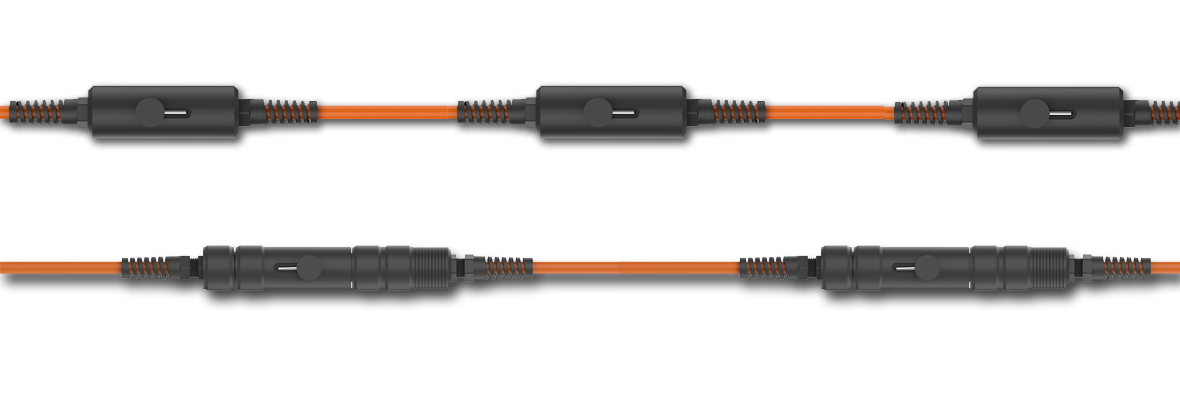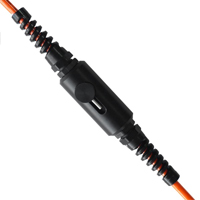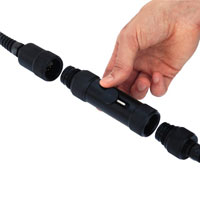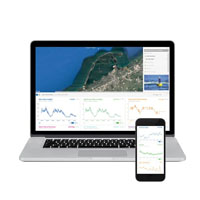Temperature affects water chemistry significantly, and as the water in a lake reaches certain chemical and temperature thresholds, phenomena such as stratification and eutrophication can occur. Moreover, processes such as flushing and thermal pollution can further impact a lake’s chemistry.
Whether the phenomena taking place in your lake are naturally occurring or not, and whether their impacts are negative or positive, lake managers need a real-time temperature profiling system to make smart decisions, and to respond to signs of trouble in enough time to stop problems.
In this post, we will describe the two kinds of thermistor strings we use to achieve these goals. We will also discuss how to work with these thermistor strings and how to configure them.
Thermistor Strings for Lake Management
Thermistor strings are the best solution for measuring lake temperature accurately, whether the goal is to measure at scheduled intervals or in real time. This is because thermistor strings enable temperature to be measured through the stratified layers of the lake’s water—something that sensors mounted individually cannot do. Thermistors are also more stable and predictable than standard thermometers and have become the industry standard sensor for controlling and measuring temperature in many verticals.
A thermistor string, also sometimes called a temperature string, thermistor chain, or temperature chain is a series of temperature elements or thermistors embedded along one cable. Every node on the cable is made up of a waterproof body containing a circuit board and a titanium thermistor. The thermistor measures the water and converts its data into a digital signal, and sends the information onward via the string.
Typically, a water sensor string suspended vertically from a buoy is the ideal way to establish a lake’s temperature profile. In general, to best develop a temperature profile that is accurate and accounts for the temperature of each layer in a lake with stratification, the design of most thermistor strings places sensors at standard intervals, such as every 3 meters.
How many thermistor strings are needed as part of a lake’s temperature stratification monitoring system varies depending on the lake’s width, depth, and other hydrological and man-made features. Typically, either a single buoy or multiple buoys with water sensor strings suspended from them can meet these needs depending on local factors.
Furthermore, buoy systems are customizable and can be shaped by the requirements of each individual lake. In small lakes, all you may need could be a single buoy with a string of several thermistors. Larger lakes, especially those with multiple outputs and inputs, might require a system of multiple buoys placed at different points in the lake, each with multiple water sensors on its thermistor string. Depending on your needs, you can even customize your string with other kinds of sensors.
Working With and Configuring a Water Sensor String
Choosing the right placements for the buoys holding your thermistor strings is a process that demands care and information. The ideal locations for the buoys that anchor your temperature profiling monitoring system will be determined by site conditions and your overall data goals. It is essential to plan carefully in order to identify potential placement locations, determine water level fluctuation and depth at each possible location, select the right places, and finally protect the instruments and other equipment by designing a reliable mooring solution.
When selecting sites for your thermistor strings, it’s possible to use a structure near the water or an anchored buoy. However, shoreline monitoring is often impractical or impossible, thanks to site conditions. Furthermore, it isn’t always possible to collect data that represents thermal stratification accurately using shoreline solutions alone. All of these factors mean that the most cost-effective and comprehensive solutions tend to be buoy-based systems.
Data buoys are stable, and they can house various sensors throughout the water column at different depths. They can also handle extended deployments because they are equipped with wireless telemetry systems, a solar-powered battery pack, and data loggers. Depending on how many sensors you require for your application and the local environmental conditions, these buoys range in size. Smaller data buoys, whose net buoyancy range from 150 to 450 pounds, are typically suitable for monitoring on inland lakes and rivers. For more extreme conditions and in larger bodies of water with more wave action, larger platforms may be needed.
Before any deployment, it is essential to check all sensors in a water bath. This ensures your data will be accurate and cuts down on maintenance issues in the future. Also, prior to deploying any buoy-based system, completely assemble the platforms, including attaching any sensors, solar panels, towers, and ballast weight as needed, onshore.
It is also important to test the entire temperature profiling system before deploying in water—including the data logger, the sensors, the software, and the telemetry. This way, your entire team has time to learn to work with the system as you can ensure that each piece of equipment is working within specifications. Never wait to troubleshoot until you’re deployed! It makes problems harder to solve and threatens the quality of your data.
The Right Thermistor String for Your Application
Depending on your goals, the right type of thermistor string is easy to identify. We offer two basic varieties of thermistor strings to meet customer demand.
The NexSens TS210 is a string with factory-built thermistors at user-specified intervals. These may be spaced as close as 0.5 meters apart, allowing for a rich, detailed dataset.
The NexSens T-Node FR is our modular string. This version of the tool allows customers to add, remove, and/or modify the string as they choose, using the connector on both ends of the thermistor. The T-Node FR strings allow customers to add sensor splitters in-line to incorporate water quality sensors, multi-parameter sondes, depth sensors, and whatever other instrumentation they need for their applications.
If you’re still not certain which thermistor string is right for your application, or want more details about customizing or configuring a water sensor string, contact the NexSens team. We will take the time to help you select the ideal tool for the job. For more information about temperature profiling, check out our comprehensive guide to temperature profiling here.
Equipment
The NexSens TS210 Thermistor String provides high precision temperature measurements for profiling in lakes, streams, and coastal waters.
The NexSens T-Node FR thermistor string provides high precision temperature measurement in an addressable and connectorized assembly.
WQData LIVE is a web-based project management service that allows users 24/7 instant access to data collected from remote telemetry systems.





0 comments